
Sand drift and landform change in coastal areas

Weekly coastal surveying

Measuring instruments
Sediment transport in coastal areas not only alters coastal and seabed topography, but also affects biota such as ecosystems. In this theme, we are studying the occurrence and spatio-temporal characteristics of sediment transport in coastal areas (oceans and estuaries), and the relationship between sediment transport and external forces such as waves and currents.
Observation of waves, currents, and drifting sand at estuaries and sea areas
We measure and analyze the waves and currents (in the ocean) and winds (on land) that cause coastal sediment transport in order to clarify how (transport mechanism) and how much (amount and direction of transport).
Elucidation of the characteristics of landform change based on long-term longitudinal beach survey results
In our laboratory, we have been surveying the coast of the Pacific Ocean side of Toyohashi City every week since the 1990s. By analyzing these topographic measurement data, we can clarify the characteristics of coastal landform changes at various time (year, season, stormy period, etc.) and spatial scales, which will be useful for coastal erosion countermeasures and beach environment conservation.
Development of a new measurement method for drifting sand
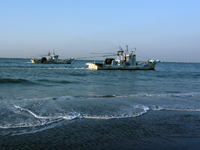
Sea trout fishing boats of the Enshu Sea operating in shallow waters

Experiments on the measurement of suspended sand using ultrasound
In our laboratory, we are researching and developing a method to detect sediment transport along the coast using ultrasonic and X-ray analysis. We are also developing a unique monitoring method to measure the seafloor topography and its change by recording and analyzing the information during the operation of fishing boats.
Development of a Monitoring Method for Suspended Solids in Rivers and Coastal Areas Using Ultrasound
We are developing ultrasonic instruments for monitoring suspended solids (especially, suspended sand) in water bodies such as rivers and coasts, and developing data analysis methods.
Study on sediment distribution characteristics and sediment dynamics using X-ray fluorescence analysis
We analyze the chemical composition of sand in beaches and rivers using X-rays, and determine the characteristics of the sediment based on the analysis results. This will be carried out along the coast of the Enshu Sea, the Tenryu River basin and the Toyokawa River basin to investigate the spatial distribution characteristics of sediment.
Development of a High-Frequency and Wide-Area Seafloor Topography Monitoring Method Using Data from the Operation of Shirasu Fishing Vessels
We aim to obtain useful information for coastal management by clarifying topographic changes and the amount of drifting sand from the obtained topographic data.”„
Research on Coastal Disaster Prevention and Safety
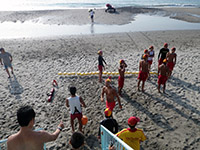
Observation at the beach with a lifesave
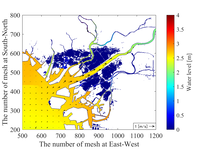
Simulation example : river run-up of storm surge
Through experiments, numerical calculations, and field surveys, we are investigating countermeasures against coastal disasters caused by tsunamis and storm surges, as well as the spread of disasters to inland and urban areas, with the aim of contributing to regional disaster prevention.
Research on disaster prevention against tsunamis, storm surges, tidal waves, and floods in coastal and estuarine areas
We aim to contribute to regional disaster prevention through numerical calculations (meteorological models, coupled wave and storm surge models, river models, etc.), field surveys, and data analysis in the coastal areas of Japan's three major bays and the neighboring Mikawa Bay and Enshu Sea.
Development of Monitoring Methods for Safe Use of Beaches
We aim to build a monitoring system that can prevent accidents such as drowning by quantifying the situation of swimmers and the occurrence of rip currents in real time using measurement techniques such as image analysis.
Research on water and biological environment in coastal areas
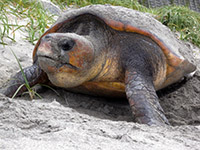
Sea turtles come ashore to lay eggs.
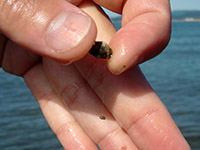
Clam fry clinging to sand particles with foot thread
In this theme, we are trying to contribute to the restoration of rich natural environment by understanding how waves, currents and drifting sand affect biological activities and aquatic environment.
Relationship between sediment dynamics and juvenile shellfish development in estuarine tidal flats
In this theme, we aim to elucidate the mechanism of clam fry development by unraveling the relationship between waves, currents, and sediment in tidal flats and the migration of clam fry.
Elucidation of the flow characteristics in a brackish lake that cause water quality changes
Field observations, data analysis, and numerical calculations are being used to elucidate the flow mechanisms that cause water quality changes in lakes.
Evaluation of Coastal and Beach Environment from the Viewpoint of Sea Turtle Reproductive Behavior
The coastline leading from Hamanako Imakiri-guchi (Shizuoka Prefecture) to Cape Irago (Aichi Prefecture) is called "Omotehama Coast" and is a valuable spawning ground for loggerhead turtles. We are investigating and researching the effects of beach environmental elements on the spawning activities of loggerhead turtles.
Copyright 2022 CoastalLAB, Toyohashi University of Technology